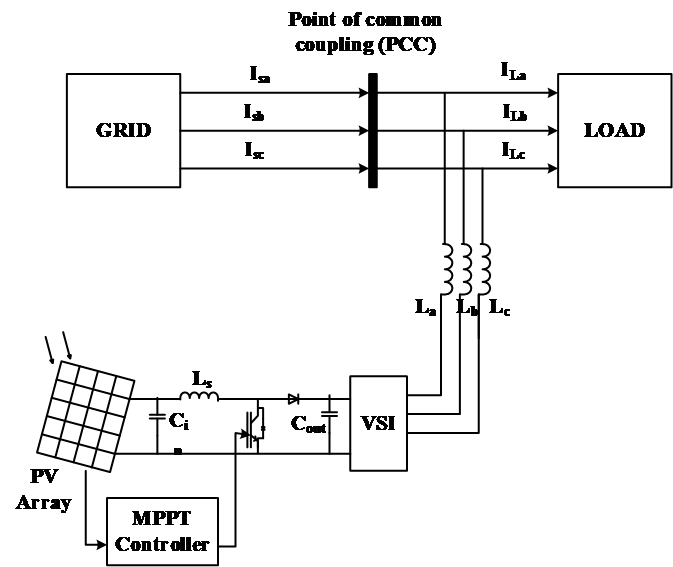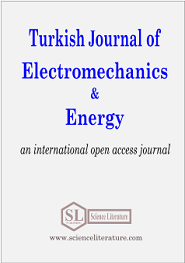
Power management analysis for V2G (Vehicle-to-Grid) applications in a microgrid with photovoltaic source
Abstract
The impact of the irregularity of the in-feed electricity on the power supply networks must be met with new concepts and technologies, such as peak shaving and reactive power management, etc. These actions facilitate also limiting carbon emission and associated footprints. This study aimed to investigate how a microgrid can support further enlargement of renewable energy source (RES) based plants as a collaborating unit in the power supply network. The microgrid consists of conventional and/or renewable energy sources, like solar energy, wind energy, bio-gas based, etc. Among these, the PV system is one of the most appreciated RESs being abundant and inexhaustible. In this study, analysis for grid-connected PV systems has been carried out to reveal the effects of electric vehicle (EV), which represents a mobile battery energy storage system (BESS). The EV could be treated as the best energy storage device under a scenario where a large number of EVs are deployed. The additional storage could not be required as the electric vehicles’ batteries themselves act as a reasonable source of energy. The fleet of EVs will ensure minimum stress on the power grid under the vehicle-to-grid (V2G) concept. The EV batteries can be charged either from the utility grid during the off-peak period or through solar PV during day-time; and during peak load hours, the same batteries can be allowed to discharge into the grid to meet peak demands. Hence, the stability of the grid can be improved by implementing the V2G concept. The simulation results show the nature of power flow in the microgrid for various operating modes implemented on the MATLAB®/Simulink platform. This study helps in planning and power management of solar PV dominating microgrid catering fleet of EVs.
Full Text:
PDFReferences
F. Mwasilu, J. J. Justo, E-K. Kim, T. D. Do, J-W. Jung, Electric vehicles, and smart grid interaction: A review on a vehicle to grid and renewable energy sources integration, Renewable and Sustainable Energy Reviews, 34, 501-516, (2014).
M. Aziz, T. Oda, T. Mitani, Y. Watanabe, and T. Kashiwagi, Utilization of Electric Vehicles and Their Used Batteries for Peak-Load Shifting, Energies, 8(5), 1-19, (2015)
O. I. Aloqaily, I. Al-Anbagi, D. Said and H. T. Mouftah, Flexible charging and discharging algorithm for electric vehicles in smart grid environment, IEEE Wireless Communications and Networking Conference, Doha, 1-6, (2016).
M. Kumar, N. Gupta, and R. Garg, Unity Power Factor Control of Grid Connected SPV system using Instantaneous Symmetrical Component Theory, 2016 IEEE 1st International Conference on Power Electronics, Intelligent Control and Energy Systems (ICPEICES), Delhi, 1-6, (2016).
N. Gupta, R. Garg, and P. Kumar, Characterization study of PV module connected to microgrid, Annual IEEE India Conference (INDICON), New Delhi, 1-6, (2015).
B. E. Layton, A Comparison of Energy Densities of Prevalent Energy Sources in Units of Joules Per Cubic Meter, International Journal of Green Energy, Taylor & Francis Group, 5, 438-455, (2008).
R. Allessandra, An In-depth Comparison: Solar Power vs. Wind Power, Knowledge Base, (2019).
A. El-Shahat and S. Sumaiya, DC-Microgrid System Design, Control, and Analysis, Electronics, 8(124), (2019).
A. Nabil. A. Ahmed, K. Al-Othman, and M. R. Alrashidi, Development of an efficient utility-interactive combined wind/photovoltaic/fuel cell power system with MPPT and DC bus voltage regulation, Electric Power Systems Research, 81, 1096–1106, (2011).
A. Hajizadeh, M. A. Golkar, Control of hybrid fuel cell/energy storage distributed generation system against voltage sag, International Journal of Electrical Power and Energy Systems, 32, 488–497, (2010).
M. Z. Daud, A. Mohamed, and M. A. Hannan, An optimal control strategy for DC bus voltage regulation in photovoltaic system with battery energy storage, The Scientific World Journal, (2014).
K. Young, W. Caisheng, W. Le, K. Strunz, Electric Vehicle Battery Technologies Electric Vehicle Integration into Modern Power Networks, 15-56, (2013).
Alternative Fuels Data Center, https://afdc.energy.gov/vehicles/electric_batteries.html, U.S. Department of Energy, [Online]. Available: http://www.eere.energy.gov. [Accessed on June 2020].
C. Tsoleridis, P. Chatzimisios, and P. Fouliras, Vehicle-to-Grid Networks: Issues and Challenges, Chapter 14, in Smart Grid, Taylor & Francis Group, pp. 347-366, (2016)
M. Yilmaz, and P. T. Krein, Review of benefits and challenges of vehicle-to-grid technology, IEEE Energy Conversion Congress and Exposition (ECCE), Raleigh, NC, 3082-3089, September, (2012).
M. Yilmaz and P. T. Krein, Review of the Impact of Vehicle-to-Grid Technologies on Distribution Systems and Utility Interfaces, IEEE Transactions on Power Electronics, 28(12), 5673-5689, (2013).
M. Yilmaz, and P. T. Krein, Review of Battery Charger Topologies, Charging Power Levels, and Infrastructure for Plug-In Electric and Hybrid Vehicles, in IEEE Transactions on Power Electronics, 28(5), 2151-2169, (2013)
A. Ul-Haq, C. Cecati, and A. Al-Ammar, Modelling of a Photovoltaic-Powered Electric Vehicle Charging Station with Vehicle-to-Grid Implementation, Energies, 10(4), (2017).
F. R. Islam and H. R. Pota, Design a PV-AF system using V2G technology to improve power quality, IECON 2011 - 37th Annual Conference of the IEEE Industrial Electronics Society, Melbourne, VIC, 861-866, (2011).
M. E. Şahin, A photovoltaic powered electrolysis converter system with maximum power point tracking control, International Journal of Hydrogen Energy, 45, (2020).
A. Ghosh, and A. Joshi, A new approach to load balancing and power factor correction in power distribution system, IEEE Trans. Power Delivery, 15(5), 417-422, (2000).
A. Ghosh, and G. Ledwich, Load Compensating OSTATCOM in Weak AC Systems, IEEE Trans. Power Delivery, 18(4), 1302-1309, (2003).
S. Kumar, and B. Singh, Control of 4-Leg VSC Based OST ATCOM using Modified Instantaneous Symmetrical Component Theory, Third international conference on Power System, ICPS, India, (2009).
K. Strunz, E. Abbasi, R. Fletcher, N. Hatziargyriou, R. Iravani, G. Joos, TF C6.04.02: TB 575 -- Benchmark Systems for Network Integration of Renewable and Distributed Energy Resources, (2014).
IRENA, Innovation outlook: Smart charging for electric vehicles, International Renewable Energy Agency, Abu Dhabi, (2019).
R. Folkson, Alternative Fuels and Advanced Vehicle Technologies for Improved Environmental Performance, 1st Edition Woodhead Publishing, (2014).
A. Vinayagam, KSV. Swarna, Y. S. Khoo, O. Yong, Aman, A. Stojcevski, PV Based Microgrid with Grid-Support Grid-Forming Inverter Control-(Simulation and Analysis), Smart Grid and Renewable Energy-Scientific Research Publishing, 8, 1-30, (2016).
M. Khederzadeh, H. Maleki, Frequency Control of Microgrids in Autonomous Mode by a Novel Control Scheme Based on Droop Characteristics, Electric Power Components and Systems, 16, 16-30, (2013).
J. M. Guerrero, L.G. Vicuna, J. Matas, M. Castilla, and J. Miret, Output Impedance Design of Parallel-Connected Ups Inverters with Wireless Load-Sharing Control, IEEE Transactions on Industrial Electronics, 52, 1126-1135, (2005).
Z. Jiang, X. Yu, Active Power-Voltage Control Scheme for Islanding Operation of Inverter-Interfaced Microgrids, IEEE Power & Energy Society General Meeting, Calgary, 1-7, (2009).
H. Han, X. Hou, J.Yang, J. Wu, M. Su, and J. M. Guerrero, Review of Power Sharing Control Strategies for Islanding Operation of AC Microgrids, IEEE Transactions on Smart Grid, 7, 200-215, (2016).
A. Vargas-Serrano, D. Saez, L. Reyes, B. Severino, R. Palma-Behnke, and R. Cárdenas-Dobson, Design and Experimental Validation of a Dual Mode VSI Control System for a Micro-Grid with Multiple Generators, IECON 2012 38th Annual Conference on IEEE Industrial Electronics Society, Montreal, 5631-5636, (2012).
URN: https://sloi.org/urn:sl:tjoee52157
Copyright (c) 2020 Turkish Journal of Electromechanics and Energy

This work is licensed under a Creative Commons Attribution-NonCommercial 4.0 International License.

 Indexed in:
Indexed in:















